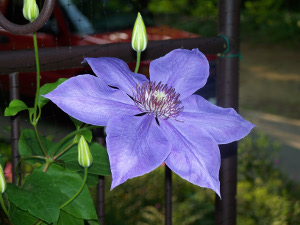Picking the Clematis That's Right for You!
We offer boodles of clematis and sometimes it's challenging - even downright confusing - to try and pick the one that's perfect for you. This guide will help you narrow your options and make choosing your clematis a little easier!

There are four basic things to consider in selecting a clematis:
- Is it Suitable for my Climate?
- What Color Should I Choose?
- What is the Proper Height?
- How Easy is it to Grow?
Climate is the long time, prevaling weather in your area. In the Frozen North, low winter temperatures are what impacts us. Every area in the United States is assigned a hardiness zone rating, based on the coldest temperature expected in an average year. You can find your zone here. All of Hummingbird Farm's clematis are hardy to Zone 4 and warmer zones; a few are hardy to Zone 3.
In warmer parts of the country, high summer temperatures can affect which clematis you choose. While we are not experts on gardening in hotter areas, we suggest that anyone in Zones 7 and higher consider carefully before selecting the Kivistik varieties and the super early types. The Kivistik varietes will bloom differently than they do here and may struggle with extreme heat. In the very hottest areas, Zones 9 and above, we recommend choosing from the viticella types (native to Mediterranean climates) and the texensis varieties (native to the southwest US).
Remember, these are general recommendations and your results may vary! For more information on gardening in hotter climates, the American Horticultural Society has developed a Heat Zone Map, which shows the average number of days over 86 degrees.
Color is the easiest to consider. If your new clematis will be near other plants, you can choose colors that will either coordinate or contrast. If it will be near a building, choose a color that will pop against that background.
For instance, a purple clematis will not show up well against a gray house. Pink, red or white clematis would be a better choice there. Other than that, it's up to you - no matter what you chose, we won't send the Plant Police after you!
Height is fairly straightforward, too. Think about where you want to put your clematis. How high can you go there? Choose a clematis no more than two feet taller than the area you have to plant.
For example: You are going to grow your clematis on the side of your garage, but the trellis you are using is only six feet tall. You can grow an eight foot tall clematis here. However, If you plan to run bird netting from the top of the trellis to the eaves of the garage (which is 10 feet tall) you could grow a 12 foot tall plant.
Ease of Growth is really important, especially for beginners. Some clematis varieties are just simpler to grow than others. We've grouped our plants into Super Easy, Very Easy, Easy and Challenging (not recommended for beginners.) These groupings are partly based on our experience growing them, but also on the success - or lack of it! - that our customers have had with them. Of course, your experiences may vary from ours! Because of that, consider them recommendations, not hard and fast rules!
Super Easy and Very Easy clematis are great choices for clematis beginners, beginning gardeners or folks that have struggled with clematis in the past. Easy clematis are great for most folks, but nervous newbies might want something more foolproof. Challenging clematis (early flowered hybrids, for those of you "in the know") are not recommended for beginners. They can be more difficult to grow, especially in really cold areas and there are lots of easier choices to make.
On this web site, you'll find clematis arranged into groups that have several things in common: Pruning Group, Ease of Growth, Height and Time, Size and Shape of Bloom.
